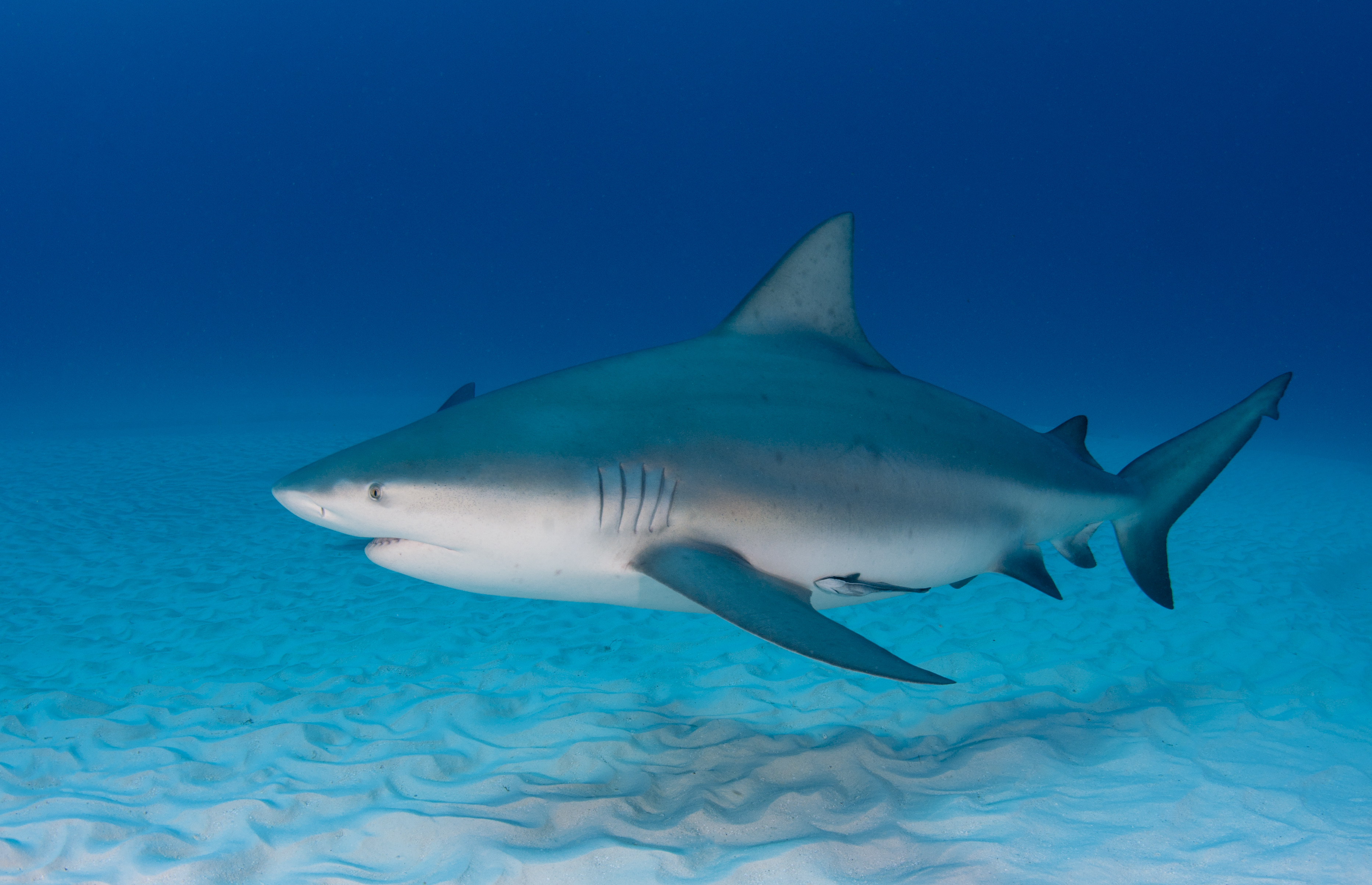
by Rick O'Connor | Jul 12, 2017
I am calling this “Summer of Sharks” as if this summer is more of a problem than others are. In fact, it is not… no more, so than any other summer –so we could call any summer the “summer of sharks”.
“Shark Fever” is more correlated with when and how the press covers the topic. During summer, more people see sharks near shore – and this is unnerving. So are there more sharks? Are there more attacks? Do the unusually warm winter and Gulf waters cause the increase?
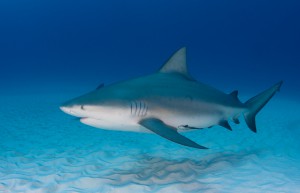
Pregnant Bull Shark (Carcharhinus leucas) cruses sandy seafloor. Credit Florida Sea Grant Stock Photo
Let us start with the first question – are there more sharks in the Gulf than there used to be?
Though most of the papers I reviewed were published over 10 years ago – they suggest several species of sharks have actually been on the decline due to incidental catch in long line operations. This reduction due to by-catch suggest a need for population management. According to the NOAA Fisheries site, the quota for commercial sharks in the Eastern Gulf of Mexico for 2016 was 127.8 metric tons (amount varied by species). The actually percent of the quota landed was around 70%. In the Western Gulf during 2016, 350.4 metric tons were allowed and between 49 – 141% of the quota (depending on species) was logged by March of 2016; at which time those federal waters were closed to shark fishing. So far, in 2017 the Western Gulf is again closed due to quota already taken while the Eastern Gulf has reached between 30-40% of the quota.
These data suggest that the fishermen in the Western Gulf are either dealing with a lot of sharks and making the quota quickly or there is heavy fishing pressure on this population.
So why more coastal encounters?
Discussing the recent increase in contact between anglers and mako sharks near Pensacola, Dr. Wayne Bennett (University of West Florida) believes this is due to more divers/fishermen in the environment and thus more encounters; and not more makos interested in inshore waters. In other words, they have always been here – there are just more of us in the environment, and thus more of us seeing them. With Go-pros and cell phones, these encounters are moving through social media and more of us are aware of these encounters. Dr. George Burgess (University of Florida) has a similar comment about recent white shark encounters along the Gulf coast.
Are there more attacks?
To answer this – we review the International Shark Attack File housed at the Florida Museum of Natural History at the University of Florida.
According to the ISAF data – 2016 was “average”. 84 unprovoked shark attacks occurred worldwide in 2016; compared to the annual mean of 82. 2015 however was a busy year with 94 unprovoked attacks logged. ISAF goes on to state there is a correlation between the time humans spend in the sea and the number of attacks that occur. They go on to state that if shark populations remain the same or increase; you might expect an increase in attacks. However, if the populations were low or declining, you would expect a decrease in attacks.
ISAF has unprovoked shark attack data going back to 1580. During that time, the United States and Australia account for 67% of all attacks – but these are two nations where the citizens really love water sports. The U.S. alone accounts for 46% of all attacks. Within the U.S., Florida accounts for 58% of all shark attacks, followed by Hawaii, California, and the Carolina’s – all states where water sports are very popular.
Just because we are interested – in Florida, 54% of the attacks have occurred in Volusia (Daytona) and Brevard counties – both very popular with the surfing public. Along the Florida Panhandle, we have Bay County (Panama City Beach) with 9 attacks, Escambia (Pensacola Beach) with 6, Okaloosa (Destin) with 3, Gulf (Port St. Joe) and Franklin (St. George Island) both with 2, and finally Walton (Seaside), and Santa Rosa (Navarre) both with 1 attack each. This is a total of 24 attacks that equates to 3% of the total number of attacks in the state of Florida since 1580.
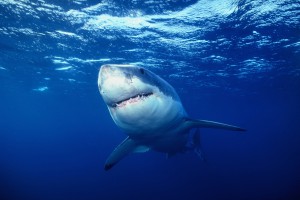
White Shark (Carcharhinus carcharias). Credit: Florida Sea Grant Stock Photo
So what does all of this mean?
- There is concern about the decline of some shark populations due to either commercial catch or commercial by-catch. NOAA is trying to manage this.
- More people are encountering sharks, but this in not believed to be due to more sharks in the water – actually, because there are more people in the water.
- Shark attacks are rare, and in the panhandle – very rare.
Therefore, the sharks are here and it is fair to say that if tourism in the Panhandle continues to increase the number of human-shark encounters will as well. It will continue to be “the summer of sharks”.
Resources:
Sharks in the Gulf of Mexico: Facts
http://www.pewtrusts.org/en/research-and-analysis/fact-sheets/2012/03/12/sharks-in-the-gulf-of-mexico-the-facts
Shifting baselines and the decline of pelagic sharks in the Gulf of Mexico
http://onlinelibrary.wiley.com/doi/10.1111/j.1461-0248.2003.00564.x/full
Atlantic Shark Commercial Fishery Landings and Retention Limit Update from January 1 – December 31, 2016
http://www.nmfs.noaa.gov/sfa/hms/news/news_list/2017/1/shk_landings_update_011717.html.
ISAF 2016 Worldwide Shark Attack Summary
https://www.floridamuseum.ufl.edu/fish/isaf/worldwide-summary/
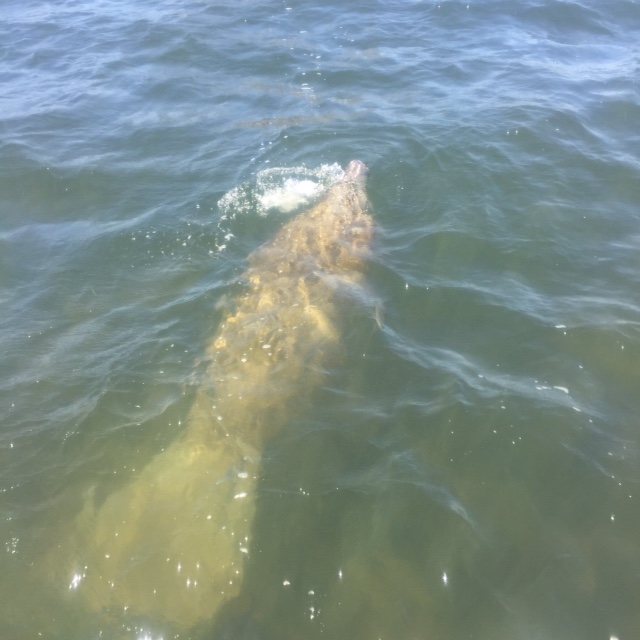
by Rick O'Connor | May 27, 2017
On May 7, 2017 Marsha Stanton spotted a manatee swimming by her pier in Big Lagoon near Pensacola. I am sure this was an exciting moment and Marsha was interested in letting someone know so that the unusual encounter could be logged.
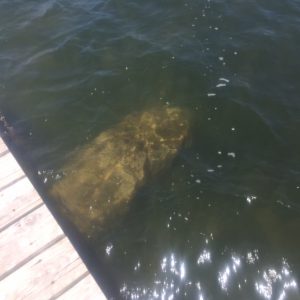
Manatee swimming by a pier near Pensacola.
Photo: Marsha Stanton
There are four species of manatee in the world; the West Indian Manatee (Trichechus manatus) is the one native to the South Atlantic, Caribbean, and Gulf region. The Florida Manatee (T. manatus latirostris) is a subspecies that is found in Florida. The historic range of the Florida Manatee included all of the Gulf coast and the east coast as far as the Chesapeake Bay. However, the increase in humans triggered a decrease in manatees. In the 1970’s it was rare to find the animal outside of the Florida peninsula.
Florida first began protecting the animal in 1893 and today it is protected by the state with the Manatee Sanctuary Act, the federal Marine Mammal Protection Act, and the federal Endangered Species Act. In the 1970’s the population of Florida Manatees was estimated to be about 1000 animals, today there are an estimated 6000. Due to the increase throughout its range, the animal has now been moved from ENDANGERED to THREATENED. In 2016, 521 manatee deaths were logged with FWC. The average for a month was 43. The majority of these were logged as unknown or perinatal (associated with the weeks before and after birth) and the highest for a month was in February. Boat strikes were logged as the largest problem for the months of January and July.
All that said, we would certainly like to protect any manatee that visit’s our area. So what can we do?
- If boating, use the marked channels. There is evidence that manatees try to avoid boat traffic by staying out of the boating areas.
- If you must leave the channel to reach your dock or the beach do so at idol speed. Wear polarized glasses and have a look out. Manatees do not break the surface as dolphins do, rather they generate “swirling eddies” as they move beneath the surface. So slow your movement and have a watchful eye and we can help reduce problems.
- If snorkeling, diving, or swimming near a manatee do not approach the animal; this can be stressful for them and could be reported as harassment by FWC; which could come with a fine. Allow the animal to move as it wishes and enjoy the experience.
- The same goes for a kayak or paddle encounter. Do not chase the manatee or separate mother from calf.
- Another issue has been feeding manatees or providing them freshwater from a hose. This practice has gone on a long time but researchers now know that this decreases the fear of humans by manatees and they return. This can cause boat strikes to increase. It is also considered harassment.
Marsha was interested in letting researchers know about this unusual encounter. However, researchers, and FWC, do not necessarily consider this as unusual as we think. Manatees have become a main stay at Wakulla Springs State Park during the colder months and are common enough in the Mobile Bay area that a manatee watch program has been developed. If the animal is distressed, injured, or you find a dead one you can report this to FWC at (888) 404-3922. If the animal is fine, healthy, and swimming just follow the basic rules listed above and enjoy a really cool experience with this really cool Floridian.
More information on “do’s” and “don’ts” can be found at
http://myfwc.com/education/wildlife/manatee/viewing-guidelines/.
http://myfwc.com/media/415226/manatee_fltreasure_bklt.pdf
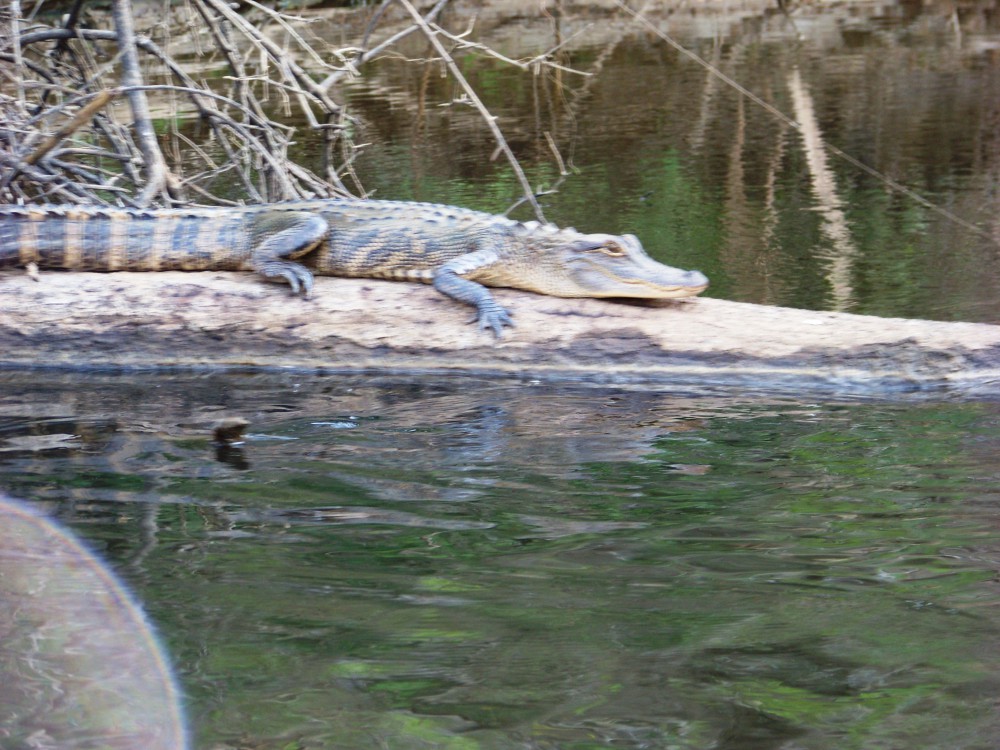
by Rick O'Connor | Apr 29, 2017
I received a call the week before Earth Day to let me know that an alligator was laying on Pensacola Beach, on the Gulf side, near the gate to Ft. Pickens. This is certainly not something you see every day.
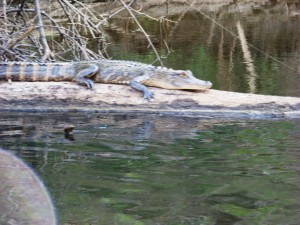
Alligator basking on the Escambia River; photo: Molly O’Connnor
Two questions came up…
One, Is this weird?
Two, Can alligators tolerate salt water?
Let us start with question 1 – is this weird?
Actually, it is not as weird as you may think. Alligators have been found on barrier islands of the northern Gulf of Mexico for decades. I myself have seen them at Big Sabine (though it has been many years since I saw one). As a student at Dauphin Island Sea Lab, we found them on Dauphin Island and on Petit Bois Island in Mississippi; I am sure they are on Horn Island in Mississippi as well. It is listed on the Gulf Islands National Seashore guide as one of the animals you may encounter in the park. They have been reported in the dune lakes of Walton County, and I have seen them at St. Andrew’s State Park in Panama City. So yea, they are found in our coastal areas – even the barrier islands. However, they do prefer the freshwater bodies of water on these islands. Which brings up the second question…
Question 2 – can they tolerate salt water?
The quick answer is yes, for a period. There are several reptiles in Florida that can tolerate periods of seawater. Those who spend long periods in brackish to marine waters have lachrymal glands to remove and excrete salt from their blood stream. This keeps the cells of their body in a more “fresh” environment and thus, can tolerate salt water for longer periods. Marine turtles, the most salt tolerant of all reptiles, excrete this salt through these glands located near their eyes. This gives them the appearance of “tears” or “crying” when they are on land. They are actually secreting salt from their body.
Alligators do not have well developed lachrymal glands. However, their tough skin is impermeable to absorbing seawater. They have thinner areas of skin where saltwater can enter and of course they can swallow seawater. Because of this, they cannot tolerate seawater very long and must eventually return to freshwater.
Alligators, like most Florida reptiles, do have to bask on land to warm their bodies in the morning. This is needed for proper digestion as well as other functions. It is also another way that alligators can avoid salty water for periods of time. I understand the alligator still had the faint yellow cross bands on its tail, indicating a younger animal, who may have wondered into the wrong location.
As far as being a danger to humans, you have to “read” the animal. Wild alligators have a natural fear of humans and would prefer to avoid us. According to the FWC, there have been 388 alligator attacks on Floridians since 1948, about 6 per year. 263 of those were considered “major” attacks, about 3 per year. 24 were fatal, about 0.4 per year (1 every 3 years). Wild alligators can be a problem if
- The animal is very large – it will consider larger prey like humans
- Attacking a pet (even on a leash) and indirectly attacking the pet owner
- Swimming in bodies of water with large alligators, especially at night (when they most often feed)
- The person was near a nest or young – alligators are very defensive of their young and nest
Any alligator can become a problem when fed. They lose their natural fear of humans and see us as a source of easy food – though they more often go after our pets, which are easier; they are more willing to approach us looking for an opportunity. Thus, is against Florida law to feed alligators.
I am not sure whether the alligator seen that week was acting aggressively or not but certainly could have been a problem. A “nuisance” alligator is defined by FWC as one being larger than four feet and acting aggressively towards humans or pets. If this is the case, they have a team of trappers who will come to collect the animal. It is not recommended that individuals try to capture these animals. As with snakes, many people bitten by alligators were trying to either catch them or kill them. It is best to leave this to the professionals.
Though it is a bit nerve racking to see an alligator on the beach, they are part of Florida’s environment. Like sharks swimming along our shores, alligators should not be approached but rather contact a local authority to alert them of the possible danger.

by Rick O'Connor | Apr 14, 2017
Growing up in the Pensacola area, I do not remember seeing many horseshoe crabs around here, but I do remember them. What I actually remember was how common they were further east in the Panama City and St. Joe area. These animals are big fans of grass beds, as are sea urchins and scallops, and all are uncommon in our area now. However, there have been local sightings in recent years, so they may be returning.

Horseshoe crabs breeding on the beach.
Photo: Florida Sea Grant
Horseshoe crabs are actually not crabs at all but members of a group of arthropods called chelicerates, which include spiders, mites, and scorpions. They differ from crabs in the absence of antenna, in which the crabs have two pairs. Their “horseshoe” shaped body is a body design to plow through the sand and mud searching for food. They are scavengers and feed on mollusk, worms, and other invertebrates – even algae at times. They do not have the large claws that blue crabs have, so they grab small bits of food where they can. Horseshoe crabs do possess a crop and gizzard and have tooth-like structures within the gizzard to grind their food. When digesting, the flesh is swallowed and the shell is regurgitated. The large spine near at the end of their bodies makes them appear similar to stingrays, which they are often confused, but the spine is actually a telson and non venomous. It is used to right itself when flipped and to push themselves in a forward direction.
They like shallow water and grassbeds are prime habitat for them. Breeding season is in the spring and early summer. During the full and new moons, both the large females and smaller males approach sandy beaches in protected areas of the bay. During the evening, they will begin to emerge into the intertidal zone where the female digs a depression and lays her eggs. The males, usually riding her back attached by a special hook, will then fertilized the eggs before they are buried. There may be more than one male trying to court the female (known as satellite males) and the numbers of horseshoe crabs on the beaches can be amazing.
Shorebirds, fish, and crabs will feed on the eggs and the young. Sea turtles are known to consume adults. Being members of the phylum Arthropoda, they will have to molt their exoskeletons as they grow. Many people will find these thin, tan-colored, molts along the shoreline.
There is a fishery for them in some parts of the southeast. They are collected for their blood, which is used in many medical processes needed for surgery and injections, and as bait for eels. The decline of these animals has been problematic for some species of migratory birds, who feed on their eggs during their migration. The horseshoe crab is also one of those rare animals that have been around longer than the dinosaurs. It would be sad to lose this animal on “our watch”. FWC is interested in where they are nesting. If you are out walking the beaches of the Florida Panhandle and encounter one of them, please contact the Sea Grant Agent at your county extension office; we are particularly interested in where they may be nesting. FWC has a website where sightings can be logged, http://www.myfwc.com/research/saltwater/crustaceans/horseshoe-crabs/documenting-beaches/.
The full and new moon cycles for spring and summer (2017) are:
Full Moon New Moon
Apr 10 Apr 26
May 10 May 25
Jun 9 Jun 23
Jul 8 Jul 23
They could nest a few days before or after. We hope you get to see one, they are pretty cool!








